Seven Advantages of Squatting
- Makes elimination faster, easier and more complete. This helps prevent "fecal stagnation," a prime factor in colon cancer, appendicitisand inflammatory bowel disease.
- Protects the nerves that control the prostate, bladder and uterus from becoming stretched and damaged.
- Securely seals the ileocecal valve, between the colon and the small intestine. In the conventional sitting position, this valve is unsupported and often leaks during evacuation, contaminating the small intestine.
- Relaxes the puborectalis muscle which normally chokes the rectum in order to maintain continence.
- Uses the thighs to support the colon and prevent straining. Chronic straining on the toilet can cause hernias, diverticulosis, and pelvic organ prolapse.
- A highly effective, non-invasive treatment for hemorrhoids, as shown by published clinical research.
- For pregnant women, squatting avoids pressure on the uterus when using the toilet. Daily squatting helps prepare one for a more natural delivery.
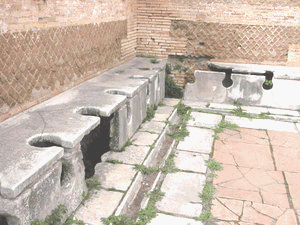
Pictures of ancient public toilets tend to confuse westerners, who assume that they were used in the sitting position. This impression is often reinforced by the pose of a comical tourist.
But, in reality, these are squattoilets.
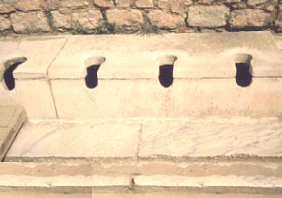
They are elevated, not for sitting, but because there is an open sewer underneath. The cutouts in the vertical wall allow people to clean themselves with water, which is done from the front when squatting. |
The ancient Romans used the posture shown below on the left. (Togas were more convenient than trousers, and provided some degree of privacy.)
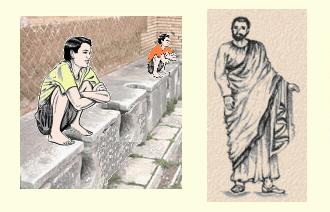
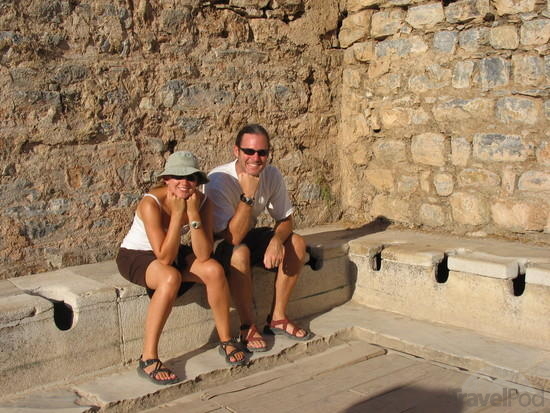
Note: The Sulabh International Museum of Toilets website claims that archeologists have found "sitting-type" toilets at ancient sites, thousands of years old. The author of the site, Dr. Bindeswar Pathak, was asked for his evidence that these toilets were used in the sitting position. He replied that he actually has no evidence, but was simply repeating the assumptions of western archeologists.
Thirty subjects participated in the study – 21 male, 9 female – ranging in age from 11 to 75 years. Each patient received a barium enema so the internal mechanics of evacuation could be recorded on an X-Ray image. Each patient was studied in both the squatting and the sitting positions.
Using these images, Dr. Rad measured the angle where the end of the rectum joins the anal canal. At this junction point, the puborectalis muscle creates a kink to prevent incontinence. Dr. Rad found that when the subjects used sitting toilets the average angle of this bend was 92 degrees, forcing the subjects to strain. When they used squat toilets, the angle opened to an average of 132 degrees. At times it reached 180 degrees, making the pathway perfectly straight.
Using squat toilets, all the subjects reported "complete" evacuation. "Puborectalis relaxation occurred easily and straightening of the rectum and anal canal facilitated evacuation. The anal canal became wide open and no folding was noticed in the terminal rectum."
In the sitting position, "a remarkable folding was created in the terminal rectum predisposing it to rectocele formation, and puborectalis relaxation was incomplete." All the subjects reported that elimination felt "incomplete" in the sitting position.
Dr. Rad also measured the distance from the pelvic floor to the perineum. In the sitting position he found that the pelvic floor was pushed downwards to a significant degree. (A detailed discussion of the connection between sitting toilets and pelvic organ prolapse – including rectoceles – can be found in thegynecological disorders section.)
Dr. Rad concluded that the use of the squat toilet "is a more comfortable and efficient method of bowel evacuation" than the sitting toilet.
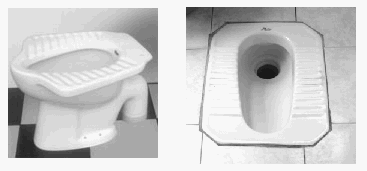
Different types of squat toilets
 Photo courtesy of Lon&Queta at flickriver.com |
The results of this experiment have been clear and unequivocal. The experimental group has suffered dramatically higher rates of intestinal and urological disorders. The following diseases are almost exclusively confined to the Western World: appendicitis, colon cancer, prostate disorders, diverticulosis, bladder incontinence, hemorrhoids, and inflammatory bowel disease.
But the results have been misinterpreted by researchers who were unaware that the experiment was even taking place. Western doctors have tried to blame these diseases on the "highly refined" western diet. Their attempts have consistently failed to show that diet is a significant factor. Conventional medical websites all tell the same story:
This is a disease of the Western World. We don't know what causes it, or why the developing world seems so strangely immune.Medical researchers have been working diligently to solve these deadly mysteries, but they have made little progress. Due to their habit of studying diseases in isolation, they failed to notice a remarkable coincidence: Many different bowel, bladder and pelvic diseases – previously rare or unknown – suddenly became commonplace in the last half of the 19th century.
This simple observation would have alerted them to the presence of a common underlying factor. It would have prompted the obvious question: What suddenly changed in the daily habits of the population?
The obvious answer: They abandoned the squatting posture for bodily functions (including childbirth.) For each disease, the anatomical relevance of this change has been explained above. The relevance is confirmed by the absence of these disorders among squatting populations.
In conclusion, the porcelain throne has caused enormous amounts of needless suffering, and the annual waste of billions of dollars in health-care costs. Clearly, the time has come to reacquaint Western Man with his natural habits – and put this unfortunate experiment to an end.
- Causes, Symptoms and Diagnosis of Diverticulosis and Diverticulitis: http://digestive.niddk.nih.gov/ddiseases/pubs/diverticulosis/
- Welles, William, "The Importance of Squatting" chapter in Tissue Cleansing Through Bowel Management, Bernard Jensen Publisher; 10th edition (June 1981).
- Jacobs E J, White E., Constipation, laxative use, and colon cancer among middle-aged adults. Epidemiology, 1998 Jul, 9 (4): 385-91.
- Tagart REB. The Anal Canal and Rectum: Their Varying Relationship and Its Effect on Anal Continence, Diseases of the Colon and Rectum 1966: 9, 449-452.
- Hornibrook, F.A., The Culture of the Abdomen, (Garden City, N.Y.: Doubleday, Doran & Co., Inc., 1933), pp. 75-78
- Aaron, H., Our Common Ailment, (New York: Dodge Publishing Co., 1938), p. 39.
- Sikirov BA. Management of Hemorrhoids: A New Approach, Israel Journal of Medical Sciences, 1987: 23, 284-286.
- Dimmer, Christine; Martin, Brian; et al. "Squatting for the Prevention of Hemorrhoids? ", Department of Science and Technology Studies, University of Wollongong, NSW 2522, Australia, published in the Townsend Letter for Doctors & Patients, Issue No. 159, October 1996, pp. 66-70 (available online at http://www.uow.edu.au/~bmartin/pubs/96tldp.html)
- Sikirov BA, Etiology and pathogenesis of diverticulosis coli: a new approach, Medical Hypotheses, 1988 May;26(1):17-20.
- Sikirov BA, Cardio-vascular events at defecation: are they unavoidable?, Medical Hypotheses, 1990 Jul;32(3):231-3.
- Bockus, H.L., Gastro-Enterology, (Philadelphia: W.B. Saunders Co., 1944), Vol. 2, p. 469
- Kira A. The Bathroom. Harmondsworth: Penguin, 1976, revised edition, pp.115,116.
- Tobin, Andrew.. Prostate Disorder – Causes and Cure, National Direct Publishing, Bowden, Australia, 1996, (Chapter 12, by Wallace Bowles, entitled "Refining an Everyday Activity"),p.132
- Ibid., p. 138.
- Cleary, Margaret, "My Child, My Teacher", New Vegetarian and Natural Health, Australian Vegetarian Society, Spring Edition, 1998.
- Henry, Dr. M.M. and Swash, Dr.M., Coloproctology and the Pelvic Floor, Butterworths London, 1985, p. 145,147,301.
- Bowles, Wallace, The Importance of Squatting for Defecation, unpublished article, January, 1992.
- The role of Reginald Heber Fitz in explaining appendicitis: http://www.ncbi.nlm.nih.gov/pmc/articles/PMC2601730/
- Walker AR, Segal I., Epidemiology of noninfective intestinal diseases in various ethnic groups in South Africa. Israel Journal of Medical Science, 1979 Apr;15(4):309-13. (online atPubMed.)
- Appendicitis and King Edward VII: www.users.bigpond.com/billmastermind/moments53.htm
- Montgomery Scott M , Pounder Roy E , Wakefield Andrew J, Infant mortality and the incidence of inflammatory bowel disease,The Lancet Volume 349, Number 9050 DATUM: 1997-02-15.
- A History of Technology, Vol.IV: The Industrial Revolution, 1750-1850. (C. Singer, E Holmyard, A Hall, T. Williams eds) Oxford Clarendon Press, pps. 507-508, 1958
- King, John E.(Editor in Chief), Mayo Clinic on Digestive Health, Mayo Clinic, Rochester, MN, 2000, p.128
- Rad, Saeed, "Impact of Ethnic Habits on Defecographic Measurements", Archives of Iranian Medicine, Vol 5, No. 2, April 2002, p.115-117.
- Russell JGB. Moulding of the pelvic outlet. J Obstet Gynaec Brit Cwlth 1969;76:817-20 (cited at http://home1.gte.net/gastaldo/part2ftc.html)
- Information on cost of hysterectomies at the Hudson's FTM Resource Guide website
- Historical Perspectives in Surgery, Medscape Surgery 4(1), 2002, "Famous Patients, Famous Operations, 2002 - Part 2: The Case of a Royal Pain in the Abdomen"
- Kirsner, Joseph B., Historical origins of current IBD concepts,World J Gastroenterol,2001; April 7(2):175-184. The relevant excerpt, regarding Inflammatory Bowel Disease: "Appearing initially as isolated cases in Great Britain and northern Europe during the 19th and early 20th centuries, they have steadily increased numerically and geographically and today are recognized worldwide."
- Roberts RO, Lieber MM, Bostwick DG, Jacobsen SJ: A review of clinical and pathological prostatitis syndromes. Urology 49: 809-821, 1997
- Latest trends in dealing with appendicitis: http://www.mja.com.au/public/issues/175_01_020701/hugh/hugh.html
- Burkitt DP. Appendicitis. London: Norgine Ltd, 1980.
- History of Hysterectomies: http://www.qis.net/~pvietz/history.htm
- Prostate cancer timeline: http://www.psa-rising.com/timeline/
- Primary Surgery, Volume One: Non-trauma, Prolapse of the Uterus (online at http://www.meb.uni-bonn.de/dtc/primsurg/docbook/html/x6935.html)
- Schulz, J.A. (2001). Assessing and treating pelvic organ prolapse. Ostomy Wound Management, 4 (5), 54-56, 58-60.
- McIntosh, Louise. The Role of the Nurse in the Use of Vaginal Pessaries to Treat Pelvic Organ Prolapse and/or Urinary Incontinence: A Literature Review, Urologic Nursing, 2005; 25 (1): 41-48.
(online at http://www.medscape.com/viewarticle/499503_3) - Information on C-Sections at International Cesarean Awareness Network.
- Transcript of Mrs. Kotarinos' talk at Interstitial Cystitis Network.
- Department of Urology | Addenbrooke's Hospital, History of Urology: http://www.camurology.org.uk/about/history_of_urology.php
- Temple NJ, Burkitt, DP, The war on cancer--failure of therapy and research: discussion paper., J R Soc Med. 1991 February; 84(2): 95–98.
- Burkitt, DP, Hiatus hernia: is it preventable?, Am. J. Clinical Nutrition, Mar 1981; 34: 428 - 431.
- Sontag, SJ, Defining GERD, Yale J Biol Med. 1999 Mar-Jun; 72(2-3): 69-80.

No comments:
Post a Comment